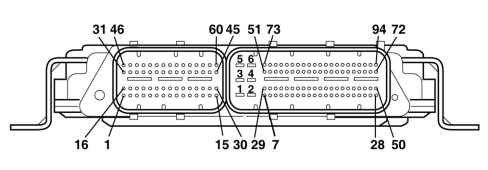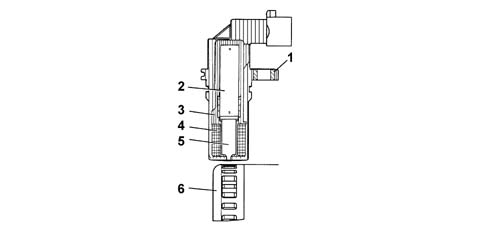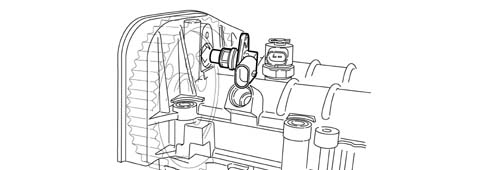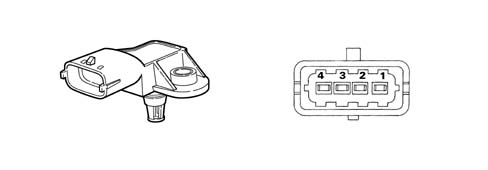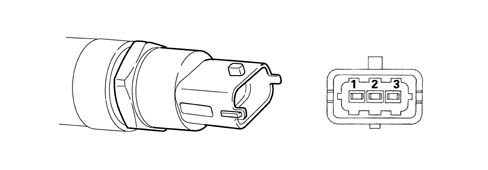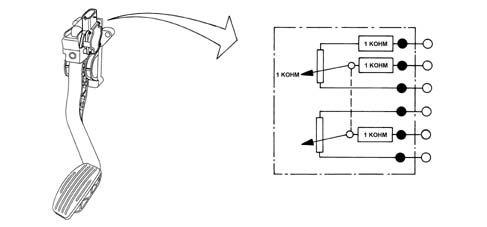939003469 - 1060G DIESEL INJECTION PRESSURE PUMP ELECTRONIC CONTROL
DESCRIPTION OF COMPONENTS
Injection control unit (EDC 16C39 common rail)
It is fitted in the engine compartnent on the right side panel. The control unit the flash EPROM type, i.e. it can be reprogrammed from the outside without affecting the hardware.The injection control unit integrates the absolute pressure sensor.PIN OUTConnector A (vehicle wiring)1 - Main services power supply2 - Earth3 - N.C.4 - Earth5 - Main services power supply6 - Earth7 - Turbine variable geometry solenoid valve signal8 - Potentiometer 2 on accelerator pedal (-)9 - Potentiometer 1 on accelerator pedal signal10 - Diesel temperature sensor (-)11 - Diesel temperature sensor signal12 - Air conditioning linear pressure sensor (-)13 - Air conditioning linear pressure sensor signal14 - N.C.15 - N.C.16 - N.C.17 - Signal + contact on brake pedal (NA)18 - N.C.19 - N.C.20 - N.C.21 - N.C.22 - Air conditioning linear pressure sensor (+)23 - N.C.24 - N.C.25 - K line26 - N.C.27 - N.C.28 - Supply29 - Compressor engagement relay feed negative signal30 - Potentiometer 1 on accelerator pedal (-)31 - Potentiometer 2 on accelerator pedal signal32 - Downstream particle filter (DPF) temperature sensor signal33 - Downstream particle filter (DPF) temperature sensor (-)34 - Upstream particle filter (DPF) temperature sensor signal35 - Upstream particle filter (DPF) temperature sensor (-)36 - Differential pressure sensor signal (DPF)37 - Differential pressure sensor (DPF) (-)38 - Resume Cruise Control39 - N.C.40 - N.C.41 - N.C.42 - N.C.43 - N.C.44 - Differential pressure sensor (DPF) (+)45 - Potentiometer 1 on accelerator pedal (+)46 - Potentiometer 2 on accelerator pedal (+)47- W line (immobilizer)48 - N.C.49 - N.C.50 - N.C.51 - N.C.52 - Heater plugs control unit fault diagnosis53 - N.C.54 - Compressor engagement request (A/C Request) from climate control/air conditioning node55 - N.C.56 - SET + Cruise Control57 - N.C.58 - N.C.59 - N.C.60 - N.C.61 - C-CAN L62 - C-CAN H63 - N.C.64 - N.C.65 - N.C.66 - N.C.67 - N.C.68 - Diesel filter heater relay feed negative signal69 - Engine cooling fan 2nd level70 - N.C.71 - EOBD failure warning light72 - Main relay feed negative signal73 - N.C.74 - Water in diesel filter sensor signal75 - N.C.76 - N.C.77 - ON Cruise Control78 - SET - Cruise Control79 - Signal - contact on clutch pedal80 - Signal + contact on brake pedal (NC)81 - N.C.82 - N.C.83 - C-CAN L84 - C-CAN H85 - N.C.86 - N.C.87 - N.C.88 - N.C.89 - N.C.90 - Engine cooling fan 1st level91 - Fuel pump relay feed negative signal92 - N.C.93 - Heater plugs activation94 - Engine cooling fan 3rd levelConnector B (engine wiring)1 - Cylinder no. 3 injector (+)2 - Cylinder no. 2 injector (+)3 - N.C.4 - Fuel pressure regulator on rail (+)5 - N.C.6 - Swirl solenoid valve earth7 - N.C.8 - Fuel pressure sensor (-)9 - N.C.10 - N.C.11 - Timing sensor (+)12 - Engine rpm sensor (-)13 - Air pressure/temperature sensor (+)14 - N.C.15 - N.C.16 - Cylinder no. 1 injector (+)17 - Cylinder no. 4 injector (+)18 - N.C.19 - Fuel pressure regulator (+)20 - Timing sensor (-)21 - Engine oil level22 - N.C.23 - Air pressure/temperature sensor (-)24 - N.C.25 - N.C.26 - N.C.27 - Engine rpm sensor (+)28 - Fuel pressure sensor (+)29 - N.C.30 - N.C.31 - Cylinder no. 2 injector (-)32 - N.C.33 - Cylinder no. 4 injector (-)34 - Fuel pressure regulator on rail (+)35 - Diagnostic feedback (swirl)36 - N.C.37 - Air temperature sensor (flow meter)38 - N.C.39 - Motorized throttle earth40 - Pressure signal from air pressure/temperature sensor41 - Engine coolant temperature sensor (-)42 - Output signal + (flow meter)43 - Fuel pressure sensor signal44 - Earth (flow meter)45 - Swirl solenoid valve control46 - Cylinder no. 4 injector (-)47 - Cylinder no. 1 injector (-)48 - N.C.49 - Fuel pressure regulator (-)50 - Timing sensor signal51 - N.C.52 - Throttle body feedback53 - Temperature signal from air pressure/temperature sensor54 - N.C.55 - N.C.56 - Insufficient engine oil pressure57 - N.C.58 - Engine coolant temperature sensor signal59 - Throttle solenoid valve control60 - EGR solenoid valveRPM SENSOR
Specifications
It is fitted on the cylinder block/crankcase facing the flywheel on the crankshaft.It is inductive type, i.e. its operation is determined by magnetic field changes generated by the teeth passing in front of the phonic wheel (60-2 teeth).The injection control unit uses the rpm signal for:
- determining the engine speed of rotation
- determining the angular crankshaft position.
Operation
The changeover from full to empty determined by the presence or absence of a gap brings about a magnetic flux change sufficient to generate an induced alternating voltage proportional to the number of teeth on the ring (or phonic wheel).The frequency and amplitude of the voltage send to the electronic control unit provides the latter with an indication of the engine angular speed.1 - Brass bush2 - Permanent magnet3 - Plastic sensor casing4 - Coil winding5 - Core6 - Ring gear or flywheel7 - Coaxial paired cable or electrical connectionThe recommended distance (gap) between the end of the sensor and the flywheel for obtaining correct signals should be 0.8 - 1.5 mm.This distance is not adjustable. If the gap is found to be outside the tolerance limits, check the condition of the sensor and phonic wheel.1 - Maximum magnetic flux2 - Minimum magnetic flux3 - Induced alternating voltageCAM ANGLE SENSOR
Specifications
This Hall effect sensor is fitted on the cylinder head facing the camshaft drive pulley.A tooth on the pulley allows the timing sensor to indicate engine timing position.The injection control unit uses the timing sensor signal to identify T.D.C. at the end of compression.Operation
A current-carrying semiconductor layer immersed in a normal magnetic field (force lines at right angles to current direction) generates a potential difference known as a Hall voltage at its terminals.If current intensity remains constant, the generated voltage depends on magnetic field intensity alone. Periodic changes in magnetic field intensity are sufficient to generate a modulated electrical signal with frequency proportional to the speed of magnetic field change. To produce this change, a tooth on the inner part of the pulley periodically moves close to the sensor.1 - Earth2 - Signal3 - SupplyINTAKE AIR TEMPERATURE AND EXCESS PRESSURE SENSOR
Specifications
The excess pressure and intake air temperature sensor is an integral component which is designed to measure the pressure and the temperature of the air inside the intake manifold.It is fitted on the intake manifold and has the task of informing the injection control unit in order to:
- regulate the pressure of the variable geometry turbine in order to ensure optimum engine performance in all operating conditions.
- regulate fuel injection duration.
1 - Earth2 - Air temperature signal3 - 5 Volt (from ECU)4 - Supercharging pressure output signalENGINE COOLANT TEMPERATURE SENSOR
Specifications
This is fitted to the thermostat cup and detects coolant temperature by means of a dual NTC thermistor with negative resistance coefficient.One NTC thermistor sends the signal to the injection control unit whilst the other sends the signal to the temperature gauge and the warning light in the instrument panel.The sensor is designed using semiconductor technology. In other words, the resistance level drops if sensor element temperature increases with increasing coolant temperature.Because the resistance does not change in linear fashion as temperature increases, it is relatively higher at low temperatures than at high temperatures.AIR FLOW METER WITH BUILT IN AIR TEMPERATURE SENSOR
Specifications
The debimeter is located on the air intake sleeve and is hot film type.1 - Air temperature sensor output signal2 - Maintenance current3 - Negative4 - 5V power supply5 - Flow meter output signalThe intake air temperature sensor is built into the debimeter. | The air flow meter cannot be disassembled. |
Operation
The principle of operation is based on a heated membrane positioned within a measurement channel that carries air into the engine.The hot film membrane is maintained at constant temperature (about 120°C higher than the incoming air temperature) by the heating coil.The air mass that flows through the measurement channel tends to remove heat from the membrane. Current must therefore flow through the coil to maintain the membrane at a constant temperature.This current is measured by a special Wheatstone bridge.The current is therefore proportional to the flowing air mass. | The flowmeter measures the air mass directly (not the volume) to eliminate problems of temperature, altitude, pressure etc. |
FUEL PRESSURE SENSOR
Specifications
It is fitted at the end of the of the single fuel manifold rail and its function is to provide the injection control unit with a feedback signal to enable it to:
- modulate injection pressure;
- regulate fuel injection duration.
1 - Earth2 - Output signal3 - SupplyACCELERATOR PEDAL POTENTIOMETER
Construction specifications
The sensor consists of a case secured to the accelerator pedal; the case contains an axially-located shaft connected to two potetiometers: a main potentiometer and a stand-by potentiometer.A coil spring on the shaft ensures the correct amount of resistance to pressure while a second spring ensures return following release.Operation
The accelerator pedal position is converted into an electrical voltage signal and sent to the injection control unit by the potentiometer connected to the pedal.The accelerator pedal position signal is processed together with the information relating to the engine rpm to obtain the injection times and the pressure.
